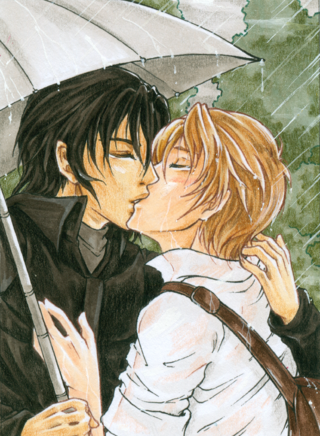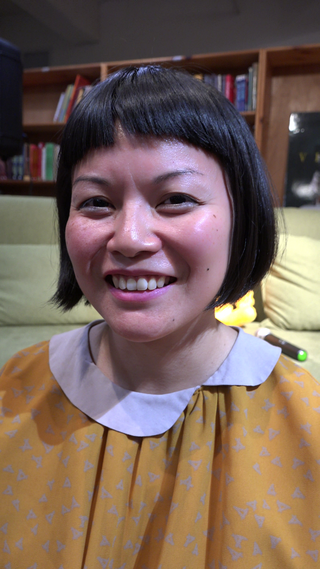Related Research Articles

Boys' love, also known by its abbreviation BL, is a genre of fictional media originating in Japan that depicts homoerotic relationships between male characters. It is typically created by women for a female audience, distinguishing it from homoerotic media created by and for gay men, though BL does also attract a male audience and can be produced by male creators. BL spans a wide range of media, including manga, anime, drama CDs, novels, video games, television series, films, and fan works.

Fantagraphics is an American publisher of alternative comics, classic comic strip anthologies, manga, magazines, graphic novels, and (formerly) the erotic Eros Comix imprint.
Alternative manga or underground manga is a Western term for Japanese comics that are published outside the more commercial manga market, or which have different art styles, themes, and narratives to those found in the more popular manga magazines. The term was taken from the similar alternative comics. The artistic center of alternative manga production was from the 1960s until the 1990s the manga magazine Garo, which is why in Japan, alternative manga are often called Garo-kei, even if they were not published in Garo.

Gengoroh Tagame is a pseudonymous Japanese manga artist. He is regarded as the most prolific and influential creator in the gay manga genre. Tagame began contributing manga and prose fiction to Japanese gay men's magazines in the 1980s, after making his debut as a manga artist in the yaoi manga magazine June while in high school. As a student he studied graphic design at Tama Art University, and worked as a commercial graphic designer and art director to support his career as a manga artist. His manga series The Toyed Man, originally serialized in the gay men's magazine Badi from 1992 to 1993, enjoyed breakout success after it was published as a book in 1994. After co-founding the gay men's magazine G-men in 1995, Tagame began working as a gay manga artist full-time.

Kuso Miso Technique is a Japanese gay manga one-shot written and illustrated by Junichi Yamakawa. It was originally published in 1987 in Bara-Komi, a manga supplement of the gay men's magazine Barazoku. The manga depicts a sexual encounter between two men in a public restroom that is complicated by the need of one of the men to relieve himself. Published in Bara-Komi to relative obscurity, Kuso Miso Technique gained notoriety as an Internet meme in the early 2000s after scanned copies of the manga were posted on Japanese imageboards and online forums.

Erotic comics are adult comics which focus substantially on nudity and sexual activity, either for their own sake or as a major story element. As such they are usually not permitted to be sold to legal minors. Like other genres of comics, they can consist of single panels, short comic strips, comic books, or graphic novels/albums. Although never a mainstream genre, they have existed as a niche alongside – but usually separate from – other genres of comics.
Sadao Hasegawa was a Japanese graphic artist known for creating homoerotic fetish art. His works are noted for their extensive detail, elaborate fantasy settings, and for their juxtaposition of elements from Japanese, Balinese, Thai, Tibetan Buddhist, African, and Indian art. While Hasegawa focused primarily on depictions of muscular male physique, he often incorporated extreme sexual themes in his works, including bondage and sadomasochism. His art is noted for strong mystical and spiritual overtones.
Bara is a colloquialism for a genre of Japanese art and media known within Japan as gay manga (ゲイ漫画) or gei komi. The genre focuses on male same-sex love, as created primarily by gay men for a gay male audience. Bara can vary in visual style and plot, but typically features masculine men with varying degrees of muscle, body fat, and body hair, akin to bear or bodybuilding culture. While bara is typically pornographic, the genre has also depicted romantic and autobiographical subject material, as it acknowledges the varied reactions to homosexuality in modern Japan.

Anne Ishii is an American writer, editor, translator, and producer based in Philadelphia. Ishii is the host of WHYY's Movers & Makers, and the Executive Director of Philadelphia's Asian Arts Initiative, an arts non-profit.
Graham Kolbeins is a Canadian filmmaker, writer, and fashion designer.
Massive Goods is a fashion brand and manga publisher. The company works with LGBTQ and feminist comic artists in Japan, particularly gay manga (bara) artists, to create products featuring their artwork, and English-language translations of their works.
Jiraiya is a pseudonymous Japanese gay manga artist and illustrator. He is noted for his homoerotic, hyperreal drawings of gachimuchi men, and for his use of digital illustration in his artwork.
Sanshi Funayama was a Japanese homoerotic fetish artist. Funayama, along with Go Mishima, Tatsuji Okawa, and Go Hirano, is regarded by artist and historian Gengoroh Tagame as a central figure in the first wave of contemporary gay artists in Japan.
Tatsuji Okawa was a Japanese homoerotic fetish artist. Tatsuji, along with Go Mishima, Sanshi Funayama, and Go Hirano, is regarded by artist and historian Gengoroh Tagame as a central figure in the first wave of contemporary gay artists in Japan.
Go Hirano (平野剛) was a Japanese homoerotic fetish artist. Hirano, along with Go Mishima, Sanshi Funayama, and Tatsuji Okawa, is regarded by artist and historian Gengoroh Tagame as a central figure in the first wave of contemporary gay artists in Japan.

Queer Japan is a 2019 documentary film directed, edited, and co-written by Graham Kolbeins. The documentary profiles a range of individuals in Japan who identify as lesbian, gay, bisexual, transgender, and queer (LGBTQ). Queer Japan is produced by Hiromi Iida with Anne Ishii, written by Ishii and Kolbeins, and features an original score composed by Geotic.

Massive: Gay Erotic Manga and the Men Who Make It is a 2014 manga anthology edited by Anne Ishii, Chip Kidd, and Graham Kolbeins, and published by Fantagraphics Books. Collecting works from Gengoroh Tagame, Jiraiya, and numerous other artists, it is the first English-language anthology of gay manga.
Takeshi Matsu is a Japanese gay manga artist.
Junichi Yamakawa is a pseudonymous Japanese manga artist, whose works in the gay manga genre were published in the gay men's magazine Barazoku and its manga supplement Bara-Komi in the 1980s. Distinguished by his works depicting male–male sexual relations with heightened and exaggerated storylines, Yamakawa is best known for his manga Kuso Miso Technique, published in Bara-Komi in 1987. While Yamakawa's manga was originally published in relative obscurity, Kuso Miso Technique gained notoriety as an Internet meme in the early 2000s, leading to newfound public interest in the artist's manga.
References
- 1 2 3 4 5 6 Walker, Calw (15 October 2019). "Bara Artist Gai Mizuki — An Exclusive Interview". J-List . Retrieved 11 January 2020.
- 1 2 3 Ishii, Kidd & Kolbeins 2014, pp. 155.
- 1 2 Ishii, Kidd & Kolbeins 2014, pp. 156.
- ↑ Kolbeins, Graham (10 March 2014). "How a Yakuza Came to Work as a Prostitute in a Soapland". Gay Manga!. Retrieved 11 January 2020.
- ↑ Ishii, Kidd & Kolbeins 2014, pp. 157.
- ↑ "Massive: Gay Erotic Manga and the Men Who Make It". Fantagraphics . Retrieved 11 January 2020.
- Ishii, Anne; Kidd, Chip; Kolbeins, Graham, eds. (18 December 2014). Massive: Gay Erotic Manga and the Men Who Make It. Fantagraphics Books.